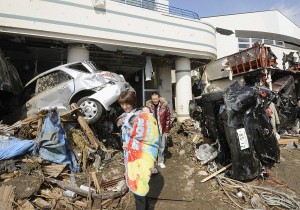Social media major tool in disaster response
HONOLULU—Backed by an array of “citizen journalists,” social media have become critical tools in coping with natural disasters, particularly in disaster-prone countries like the Philippines, according to experts from the United States and Japan.
Pictures and stories about the tsunami that killed over 200,000 people in a dozen Asian countries in 2004, Hurricane “Katrina” in the United States in 2005, Tropical Storm “Ondoy” in the Philippines in 2009, the Haiti earthquake in 2010 and the tsunami that struck Japan in 2011 point to a wealth of information supplied by “citizen journalists” in times of calamities.
“(From what) you saw in Haiti, in Japan (and) in the Philippines, social media are becoming more and more a critical component of influencing policy and causing action,” Allen Clark, a senior consultant at the Pacific Disaster Center in Hawaii, told the Philippine Daily Inquirer.
Clark, a senior fellow at the East-West Center here, said the more people were involved on the ground, the quicker the response would be in times of disasters.
The use of the social network also allows for instant reporting of health issues, making immediate response absolutely critical, as in the cholera outbreak in Haiti and the dengue flareups in Thailand and Indonesia, he said.
Inaccuracies purged out
“One of the things we found out in getting aid into an area is understanding the accessibility of that area and only the people on the ground or the ‘citizen journalists’ have that information immediately,” Clark said. “That is a very particular component of disaster response.”
Clark spoke recently with print, broadcast and online journalists from the United States, Japan, China and Asian and Oceanic countries bordering the tectonic Pacific Plate.
They participated in the East-West Center’s Disaster Management and Resiliency in the Asia-Pacific Journalism Fellowship, a study program designed following last year’s Fukushima disaster in Japan.
Clark believed the posting of inaccurate and irresponsible information on the social network was not a big problem.
“You will always have inaccurate information … Social media may put anomalies into the system for whatever reason, but I think they’re pretty rapidly purged out of the system as well,” Clark said.
“So keep in mind that the more people are involved, the higher the accuracy level of the reporting is going to be because you can’t simply put anomalies into the system,” he stressed.
Force to reckon with
Clark agreed that the social media, such as Facebook, YouTube, Twitter, blogs and SMS, are a force to reckon with.
James Burke, associate director of Course Development and Delivery in Hawaii’s National Disaster Preparedness Training Center, said disaster centers worldwide should make full use of the social media’s tools and methods for crisis communication in order to save more lives.
In Palo Alto, California, Christian Adams, product manager of Geo and Maps Team of Google Crisis Response (GCR), said the relevance of citizen reporting became apparent in 2005 when Katrina struck New Orleans. This resulted in the birth of GCR.
At that time, Adams said rescuers had difficulty locating both survivors and fatalities as there was no way for helicopters to find the addresses of people.
“People use Google to give coordinates so they can be located, and they were updating the information showing the flooding. That started our (GCR) team,” he said.
Great story
Japan is GCR’s largest deployment today, followed by Haiti.
Adams recalled that in the first days of Katrina, there was an urgent need to provide maps and information alerts.
Thus, GCR came up with three major products—the Google People Finder, where people can search for those who are missing; the Google Crisis Maps, which provide satellite imagery of the disaster; and the Google Public Alerts.
Adams said a great story on the role of the social media happened in Japan when people displaced by the tsunami started sending e-mails via mobile phones and set up an area where everyone took pictures and posted them on Google.
According to Adams, the GCR does not filter what information to post as these all come from the people. These are followed by information from official sources, like government agencies.
“What we do before we publish is indicate the sources. So you make your own judgment yourself as to the accuracy of the information,” he said.
Information overlap
Ka Ping Yee, software engineer of GCR’s Geo and Maps Team, said the social media complemented the traditional media in providing quick information.
“We see it as our duty to provide information and that’s part of the Internet,” Ka said. “People must learn how to judge data. You may be saying there may be an overlap between what we do in providing information and what you do in leveraging information. As journalists, you could use the Google Crisis Map to tell a story.”
Back home, Benito Ramos, executive director of the National Disaster Response and Risk Management Council (NDRRMC), said the council started using the social media as tools in disaster response this year.
He said the NDRRMC has incorporated Facebook and Twitter in its monitoring system and website for quick response.
Leave it to experts
Clark said that while political leaders should stay out of it by leaving it to the experts, having a Philippine President at the forefront of relief operations for people hit by disasters was a positive point.
“People in general are looking for some sort of assurance that there is a future and the only person who can provide that assurance is the president,” Clark said. “It gives them hope and it almost always lays out a plan, although very general, on how to move ahead.”
Also important is a country’s calamity fund, which sets aside a given amount of funding that is immediately accessible and not subject to all kinds of discussions, he said.
“You cannot escape the fact that the more quickly you respond, the more quickly you will recover and the better the recovery will be,” Clark said.
